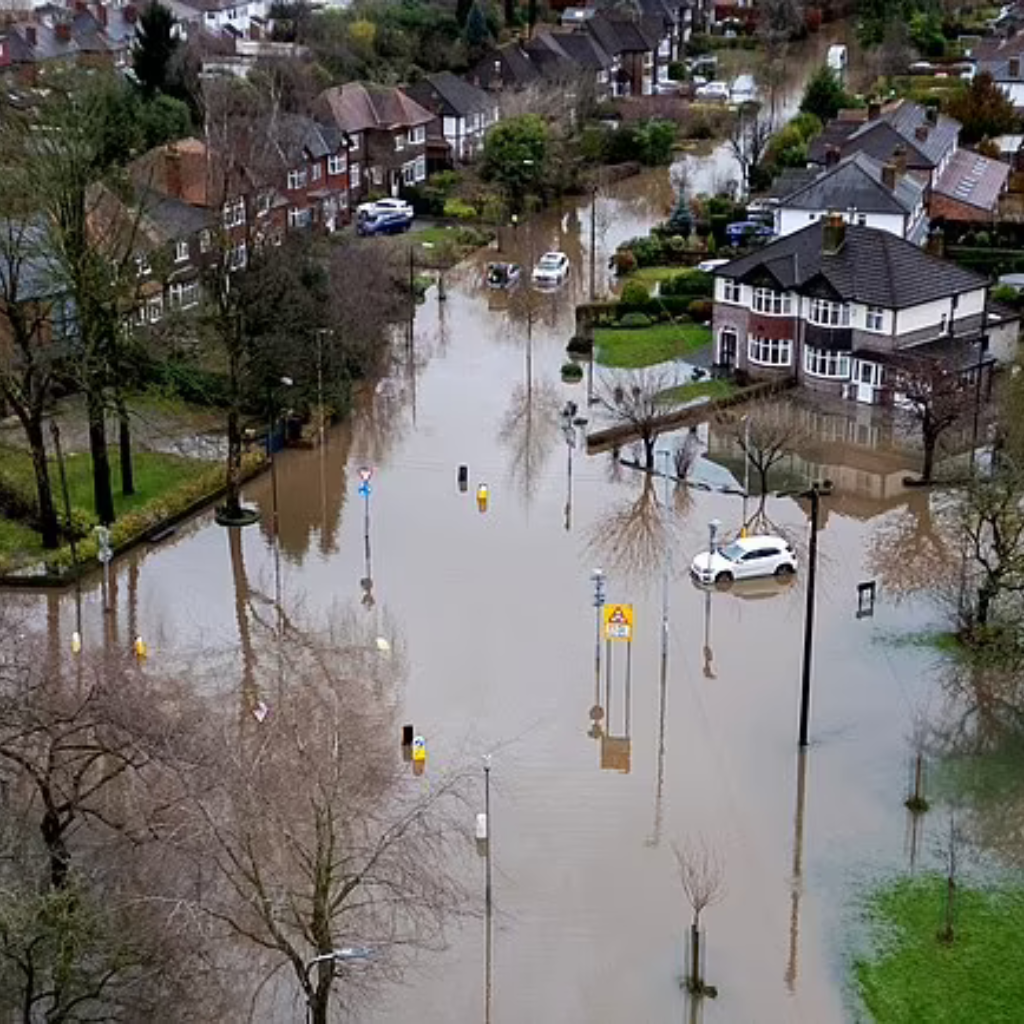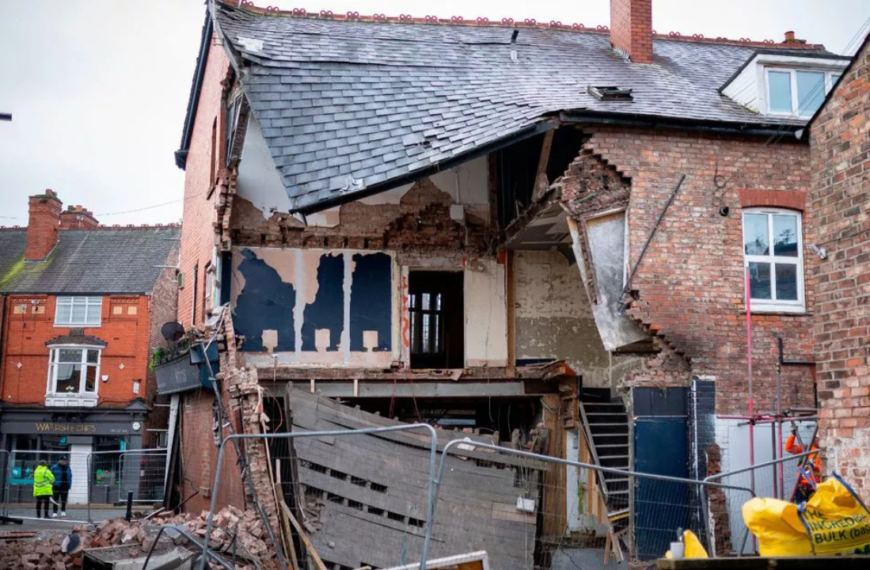The New Year began on a grim note for Altrincham, as torrential rains swept through the area, leaving a trail of destruction. What started as heavy rainfall quickly escalated into widespread flooding, submerging streets, homes, and cars. For many residents, this was the worst flooding event they had ever experienced, bringing life to a standstill and forcing authorities to declare a major incident.
Greater Manchester Police made the critical announcement, urging residents to stay indoors unless travel was absolutely necessary. The deluge overwhelmed the town’s infrastructure, with water levels rising dangerously high and catching many by surprise. The floods disrupted transportation, damaged property, and created significant risks to safety, leaving the community grappling with the chaos.
Among the most notable impacts was the breaching of the Bridgewater Canal at Dunham Massey—a momentous event, as this breach marked the first occurrence since 1971. The incident not only highlighted the severity of the flooding but also underscored the broader challenges posed by extreme weather events.
This catastrophic start to the year serves as a stark reminder of the devastating power of nature. The flooding has triggered a united response from local authorities and emergency services, who are working tirelessly to manage the crisis and support affected residents. As the waters continue to recede, the community is left to assess the damage and plan the long road to recovery.
Bridgewater Canal Breach
One of the most dramatic outcomes of the flooding was the breach of the Bridgewater Canal at Dunham Massey, a historic event that has not occurred since 1971. The breach unleashed large volumes of water into nearby areas, exacerbating an already dire situation. For decades, the canal had stood as a reliable feature of the region’s landscape, but the unrelenting rainfall proved too much for its embankments.
The immediate impact of the breach was widespread flooding in surrounding neighborhoods, with water pouring into roads and properties. The breach disrupted daily life, leaving residents and businesses struggling to protect their premises from the encroaching waters. Emergency teams worked tirelessly to contain the damage, but the scale of the flooding highlighted the vulnerabilities in the area’s infrastructure.
Flooded Areas and Stranded Vehicles
The flooding wreaked havoc across Altrincham, submerging key roads and leaving vehicles stranded in rising waters. Shaftesbury Avenue, particularly at its junction with Aimson Road, became impassable, with several cars abandoned mid-journey. The junction of Woodlands Parkway and Wellington Road was another heavily affected area, turning into a hazardous zone for drivers and pedestrians alike.
Other roads, such as Brook Avenue, Brook Lane, Tannery Way, and Brooklands Road, also bore the brunt of the flooding. Local residents reported water invading cellars, garages, and gardens, adding to the extensive property damage. These disruptions highlighted the severity of the crisis and the urgent need for support to affected areas.
Residential and Property Damage
The Environment Agency issued multiple flood warnings, signaling the danger posed to residential properties in the region. Areas near Green Lane, Woodlands Road, and Canal Road were particularly at risk, with specific warnings for homes near King George Fifth Pool and Deansgate Lane.
Streets such as Woodbourne Road, Sylvan Avenue, Greenway Road, and Wilford Avenue were among those hit hardest, with water levels flooding homes and disrupting daily life. Reports of submerged cellars and waterlogged gardens were common, as residents worked tirelessly to salvage belongings and prevent further damage. The scale of property damage underscored the widespread impact of the flooding, leaving many families facing significant recovery challenges.
Infrastructure Impact
The flooding also severely disrupted the area’s infrastructure. The M56 westbound motorway between junctions 6 and 7 was forced to close due to dangerous water levels, causing significant travel delays and impacting regional connectivity.
Meanwhile, at Sinderland Brook in Partington, water levels reached 1.48 meters—well above the threshold of 1.35 meters that signals possible property flooding. This highlighted the precarious situation faced by many homes in low-lying areas and the urgent need for continued monitoring and intervention.
Environment Agency Flood Warnings
A total of 55 flood warnings were in place across Greater Manchester during the peak of the crisis. The warnings, which indicate that flooding is expected and action is necessary, covered key areas such as Timperley Brook, River Bollin in Little Bollington, and Baguley and Fairywell Brooks.
These alerts emphasized the critical need for residents to remain vigilant and take immediate steps to protect themselves and their properties. The widespread issuance of warnings underscored the unprecedented nature of the event and the strain on local resources.
Community and Emergency Response
In response to the crisis, Greater Manchester Police urged residents to avoid unnecessary travel, emphasizing the importance of safety amid hazardous conditions. Emergency services were deployed across the region to rescue stranded vehicles, assist affected residents, and contain the damage.
Community members also rallied to support one another, sharing resources and offering assistance to those in need. The spirit of resilience and solidarity became a defining feature of the response, showcasing the strength of the Altrincham community during an extraordinarily challenging time.
Aerial Perspective and Visual Impact
Aerial footage of the affected areas painted a sobering picture of the disaster. Roundabouts, such as the one connecting Wellington Road and Woodlands Parkway, appeared as vast pools of water, with submerged vehicles and abandoned streets. The bird’s-eye view highlighted the sheer scale of the flooding and the challenges faced by emergency responders.
Read more: Est Italian closes after being hit with massive repairs and decoration bill by landlord
Conclusion
The severe flooding in Altrincham has been a stark reminder of the unpredictability and destructive power of nature. With the first breach of the Bridgewater Canal in over half a century, widespread property damage, and disrupted infrastructure, the community faces a daunting recovery.
As the waters recede, the focus now shifts to rebuilding and strengthening the area’s resilience against future extreme weather events. The collective efforts of residents, authorities, and emergency services will undoubtedly play a crucial role in overcoming this crisis and preparing for the challenges ahead.


















